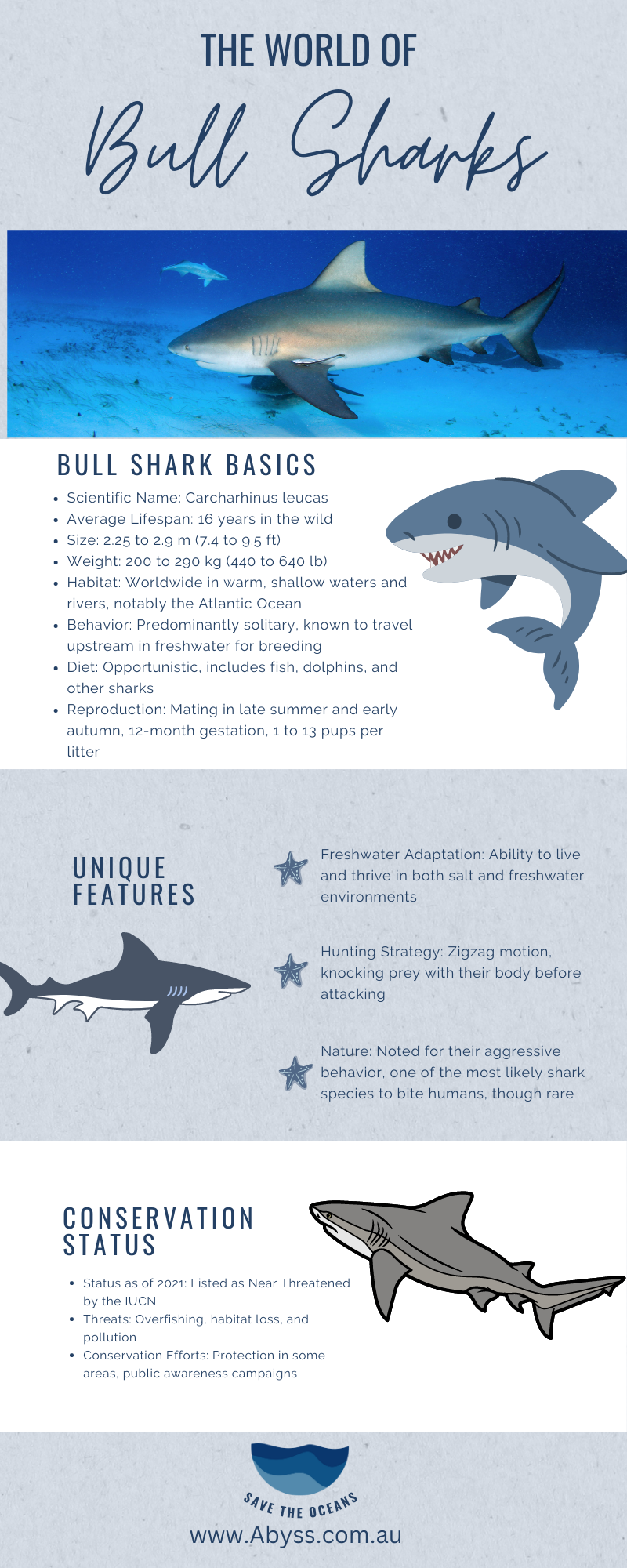You have 0 product(s) in your cart.
Abyss Scuba Diving
Fascinating Facts About The Bull Shark (carcharhinus Leucas)

Fascinating Facts about the Bull Shark (Carcharhinus leucas)
Dive into the fascinating world of bull sharks (Carcharhinus leucas), one of the most unique and captivating shark species on Earth. In this blog post, we’ll unveil the mysterious life of these remarkable creatures, from their incredible adaptability as bull sharks to both salt and freshwater environments to their powerful bite force and diverse diet. Prepare to embark on an exciting journey as we explore the extraordinary characteristics and behaviours of this magnificent predator, the bull shark.
Short Summary
-
Bull sharks are powerful predators with an impressive ability to survive in both salt and fresh water.
-
They have a wide distribution, complex social dynamics, and specialized adaptations for freshwater living that make them distinct from other shark species.
-
Conservation efforts are being implemented to protect bull sharks from threats such as hunting, habitat destruction, predation & commercial fisheries.
Bull Shark Basics

Bull sharks are a truly remarkable shark species, known for their stout bodies, blunt snouts, and impressive ability to inhabit both salt and freshwater environments. As members of the requiem shark family, they are commonly found in warm, shallow waters along coasts and in rivers around the world. Juvenile bull sharks, as well as adult bull sharks, usually measure around 3.5 meters in length and can weigh approximately 300 kilograms. In particular, a male bull shark exhibits similar characteristics to its counterparts.
Their name is derived from their stout form, broad, flat snout, and aggressive, unpredictable behaviour, distinguishing them from other sharks such as the tiger shark.
Carcharhinus leucas
Carcharhinus leucas is the scientific name for the bull shark, with “leucas” meaning white in Greek, referring to their pale underbelly. These powerful predators, known as bull sharks carcharhinus leucas, are widely regarded as one of the most dangerous shark species, having been documented to cause over 100 unprovoked attacks on humans globally, with 27 of those attacks resulting in fatalities. Despite this fearsome reputation, bull sharks are not typically targeted in commercial fisheries, though they are commonly encountered in bottom longline gear along with other bull sharks.
One of the most infamous bull shark encounters is believed to be the 1916 Jersey Shore attacks, which resulted in four fatalities over a 12-day period. This notorious event has been widely attributed to bull sharks, including both male and female individuals. The fact that bull sharks can be found in both saltwater and freshwater habitats, sometimes venturing thousands of kilometres up rivers like the Amazon and Mississippi, only adds to their potential danger to humans.

Distribution and Migration

Bull sharks inhabit warm, shallow coastal waters and rivers worldwide, including the Amazon, Mississippi, Brisbane, and the Ganges. They are typically found in depths of less than 100 feet (30 meters) and are known to enter estuaries, bays, harbours, lagoons, and river mouths. Their presence in various habitats can influence their diet, which consists of a wide variety of prey like fish, dolphins, sea turtles, rays, birds, and other sharks.
These fascinating creatures are known to migrate seasonally, especially for breeding purposes. Some bull sharks in the Amazon River, for example, swim over 3700 kilometres up and down the river on a seasonal basis. Research indicates that bull sharks may be capable of breeding in freshwater, although it appears to occur less frequently than in estuarine and marine habitats.
Bull sharks prefer warm currents, which makes them more likely to be found in tropical and subtropical regions around the globe. Their wide distribution and adaptability to various environments make them a truly fascinating species to study.
Adaptations for Freshwater Living
One of the most intriguing aspects of bull sharks is their unique ability to thrive in both salt and freshwater environments. They possess specialized adaptations, such as altered kidney and gland functions near their tails, enabling them to maintain salt levels despite being in freshwater. This incredible adaptability is made possible by their euryhaline system, a system that allows them to maintain a salt and water balance in their bodies.
Bull sharks have been observed in various freshwater habitats, such as the Caloosahatchee River estuary, where a study was conducted to ascertain the movement patterns of young bull sharks. These fascinating creatures are even able to tolerate hypersaline water up to 53 parts per thousand.
This remarkable ability to survive in diverse environments sets bull sharks apart from most other shark species and contributes to their widespread distribution. As a result, they can be found in:
-
rivers
-
lakes
-
estuaries
-
coastal waters
-
sometimes venturing thousands of kilometres inland.
Feeding Habits and Prey

Bull sharks are opportunistic feeders, and their diet consists of a wide variety of prey, including:
-
fish
-
dolphins
-
sea turtles
-
rays
-
birds
-
other sharks
They employ a bump-and-bite technique to capture their meals, initially making contact with their intended target before persistently biting and tackling their prey until it is unable to escape.
As solitary hunters, bull sharks typically search for food on their own, although they have been observed to pair with another bull shark for a short period of time in order to increase their chances of catching prey. When food is scarce, their digestion slows to conserve the available resources and prevent starvation.
The diverse diet of bull sharks includes:
-
Fish
-
Crustaceans
-
Squid
-
Turtles
-
Birds
-
Dolphins
-
Other sharks
This adaptability and ability to inhabit a variety of environments, from coastal waters to freshwater rivers and lakes, allows them to take advantage of a wide range of food sources, making them highly successful predators.
Social Dynamics and Reproduction

Bull sharks exhibit interesting social behaviours, with females typically dominating males in their social structures. They often hunt in groups and are known to mate during the late summer and early autumn months. Gestation for bull sharks lasts between 10 and 11 months, and females typically give birth to between 1 and 13 live young.
Coastal lagoons, river mouths, and other low-salinity estuaries serve as ideal nursery habitats for bull sharks, providing protection and abundant food sources for the young as they grow and develop. As they mature, these sharks continue to thrive in a diverse range of environments, from saltwater coastal areas to freshwater rivers and lakes.
Threats and Conservation Efforts

The main threats to bull sharks include human activities such as hunting and habitat destruction and predation by other sharks and crocodiles. Bull sharks are hunted for their oil, hide, and meat, though they are not typically targeted in commercial fisheries. The International Union for Conservation of Nature states that bull sharks are listed as near threatened (NT).
Various conservation efforts are being undertaken to protect bull sharks. The Nature Conservancy is satellite tagging sharks to monitor their migration patterns and identify their habitats, which can guide the implementation of protection projects in the necessary areas. Other efforts include the development of the SharkSafe BarrierTM technology, which requires further improvement and testing before it can be utilized as a dependable safety measure.
By understanding the threats faced by bull sharks, a threatened species, and working to develop effective conservation solutions, we can help to ensure the survival of this remarkable species for generations to come.
Notable Bull Shark Encounters

One of the most infamous bull shark encounters was the 1916 Jersey Shore attacks, which resulted in four fatalities over a 12-day period. This notorious event has been widely attributed to dangerous sharks, including both male and female bull sharks, and serves as a chilling reminder of their potential danger to humans.
Another notable encounter involves the capture of large, pregnant females in the Arabian Sea, with bull sharks caught in this region. This finding highlights the wide distribution of bull sharks, including the Zambezi shark, and their ability to inhabit diverse environments, from coastal waters to freshwater rivers and lakes, even earning them the nickname “river shark.”
These encounters underscore the importance of understanding and respecting the power and potential danger posed by bull sharks. By learning more about their behaviours, habitats, and conservation needs, we can work to minimize the risk of negative interactions between humans and these magnificent predators.
Comparisons with Other Shark Species

When compared to other shark species, bull sharks stand out in several ways. They have the strongest bite pressure among sharks of similar size, making them formidable predators. Additionally, they are more aggressive than most species, often being compared to tiger sharks due to their similar size and reputation for aggression.
Another unique feature of bull sharks is their ability to inhabit both salt and freshwater environments, thanks to their specialized adaptations, such as their euryhaline system and altered kidney and gland functions. This sets them apart from most other shark species and allows them to thrive in a diverse range of habitats.
These comparisons highlight the exceptional nature of bull sharks and their distinctive characteristics. By understanding what sets them apart from other shark species, we can better appreciate their unique role in the marine ecosystem and work to protect these fascinating creatures.
Summary
In this blog post, we have explored the captivating world of bull sharks, delving into their unique characteristics, behaviours, and habitats. We have discovered their incredible adaptability to salt and freshwater environments, diverse diet, and powerful bite force. We have also discussed their threats and ongoing conservation efforts to protect this remarkable species.
As we continue to learn more about bull sharks and their fascinating lives, we can work together to ensure their survival in our oceans and rivers. By understanding and respecting these magnificent predators, we can foster a greater appreciation for the natural world and its incredible creatures.
Frequently Asked Questions
Do bull sharks attack humans?
Bull sharks can be aggressive and have been known to bite people in areas they inhabit, so they are likely to attack humans.
However, it is important to note that attacks on humans are rare and that bull sharks are not considered to be a major threat to humans.
Do bull sharks live in Australia?
Yes, bull sharks can be found in Australia, with their range covering the coastlines from southwestern Western Australia to the central coast of New South Wales.
Juveniles have even been spotted up to 110 km inland in very low salinity environments.
Are bull sharks aggressive?
Bull sharks are known as the strongest, most aggressive and most dangerous sharks in our waters. They are often considered to be the most dangerous sharks to humans because of their aggressive tendencies and ability to migrate up rivers.
Some authors even consider that the Bull Shark may be more dangerous than the White Shark and the Tiger Shark due to its omnivorous diet and habitat preferences.
What is the difference between a tiger shark and a bull shark?
Bull sharks typically inhabit shallow waters and are known to prey on fish, turtles, and birds, whereas tiger sharks tend to live in deeper ocean waters and can be found near coral reefs.
What is the largest bull shark on record?
The largest bull shark on record was a healthy female estimated to be 3 meters long and weighed around 450 kilograms; She earned the name ‘Big Bull’ for her impressive size, which was significantly larger than other bull sharks of similar length.
This size was remarkable, as bull sharks typically grow to a maximum of 8 feet in length. Big Bull was an outlier, and her size was a testament to the species’ potential for growth.
RELATED POSTS
-
Uncovering the Facts of the Hammerhead…

Uncovering the Facts…
Uncovering the Facts of the Hammerhead Shark Did you know that hammerhead sharks possess a unique head shape […] -
Exploring the Wobbegong Shark: A Dive…

Exploring the Wobbegong…
A Comprehensive Guide to the Vanishing Wobbegong Shark Are you familiar with the wobbegong shark, also called […] -
Great White Sharks Habitat | Great…

Great White Sharks…
Great White Sharks Habitat Great White Shark was known best for his roles on Jaws. It is considered the most […] -
Shark Diving Sydney | Abyss Scuba Diving

Shark Diving Sydney…
Shark Diving Sydney - An Exciting Adventure Sharks are amazing to observe in their natural habitat. Sharks […]
Recent Posts






